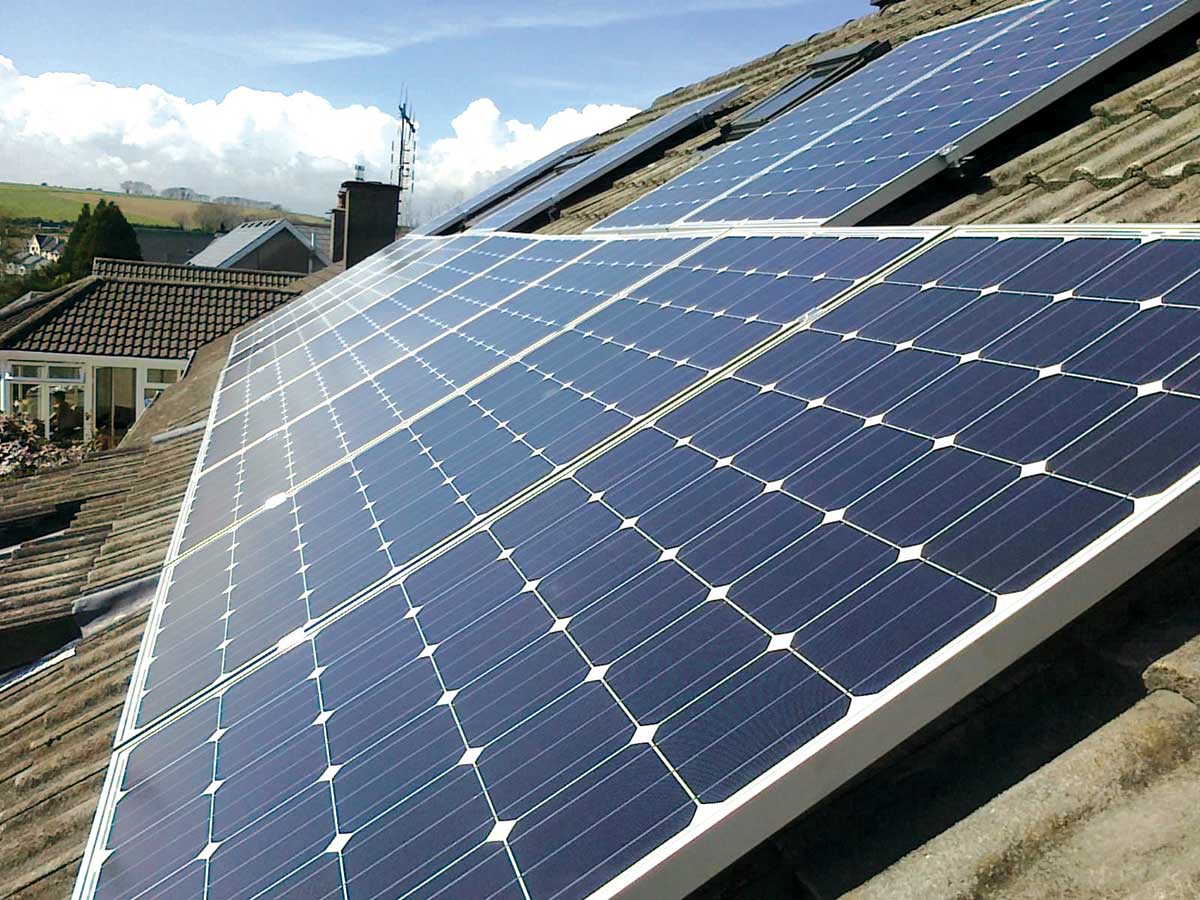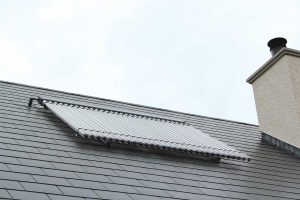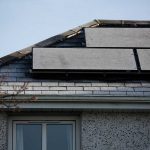With the price of photovoltaic (PV) modules falling significantly since 2009, by up to 80 per cent depending on installation type, it’s starting to really make sense to invest in solar.
In this article we cover:
- Solar thermal panels that make hot water: types and costs
- PV panels that make electricity: types and costs
- Ground versus roof mounted
- Typical solar panel installation
Ireland actually enjoys a very healthy amount of solar radiation, not unlike that of the South of England. To make the most of it in your home, you can install solar panels
Solar thermal are solar panels that generate hot water, and photovoltaic panels are solar panels that generate electricity.
Know that in ROI grants are available for both hot water and PV panels.
Solar thermal: hot water panels
Solar water heating depends on energy from the sun so it is unable to provide continuous supplies of hot water throughout the year. The ballpark figure is that it can provide hot water for a household’s washing and bathing needs for about half to two thirds of the year.
Therefore a back up system will be required, usually in the form of a boiler. Even though you can increase the number of panels the law of diminishing returns comes into play when trying to achieve higher solar fractions with larger collector areas, though it is also true that a large percentage of the overall cost is in the cylinder and control systems, so adding panels does not increase the price greatly.
Surplus hot water can be directed to a radiator, usually in the bathroom or if you don’t want more heat in the room, in the loft. Some systems such as drain back are specifically designed to effectively go to sleep when not required. Or perhaps this is just the excuse you needed to indulge in that hot tub…
In a new build a system sized for a family of four might set you back in the order of €4,000/£3,500 but it could be double that amount in an existing house due to the complexities of adding them onto an existing heating system and related construction work. Grant for Solar panels for existing homes (built before 2006) are available in ROI contributing €1,200 towards the cost. Yearly savings as compared to an oil boiler only set-up can amount to €300 to €800.
Ground vs roof mounted solar thermal panels
In ROI exemptions are in place for both roof mounted and ground based solar PV arrays for households (microgeneration) but with caveats. For instance, permission is not required for
roof mounted systems up to 12sqm provided they are more than 50cm from any roof edge, among other criteria.
In NI roof mounted solar systems do not need planning permission as long as they meet some basic criteria, e.g. the panels don’t exceed the boundary of the roof or the highest part of the roof while ground mounted systems must not exceed 14 sqm in area and 2m in height.
Bear in mind that the size of the hot water cylinder is important to size correctly – the bigger it is the more hot water you have for your family but also the longer it takes to bring to temperature. A cylinder that’s too big for the solar system will achieve a useful hot water temperature less often than a suitably sized cylinder.
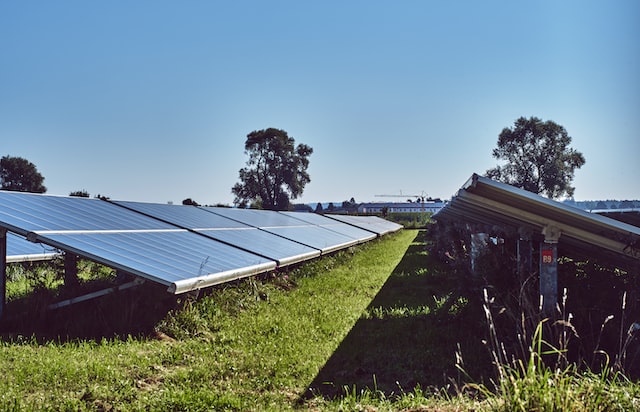
Tube vs flat solar panels
There are two types of collector, the vacuum tube collector and the flat plate collector. The first of these comprises rows of tubes with each one plugged in to a manifold through which the transfer fluid flows. The tubes are evacuated to reduce convection losses and this type of collector cannot normally be integrated into the roof but is easier to retrofit because they are lighter to lift into place and have a reduced wind loading.
A flat plate collector consists of a large sheet of metal with a selective coating to maximise heat absorption. This plate has pipework carrying the transfer fluid and is held within an insulated box. The glazing is normally glass but polycarbonate plastic may be used in coastal locations to reduce weight.
‘If properly designed and installed, solar water heating systems should give many years of trouble free service.’
Plastic has an advantage in that it can be moulded to custom shapes and sizes, but it can also be scratched. In contrast to the tube collector, flat plates can be integrated into the roof as well as sit proud. With careful design, it is sometimes possible to mount a panel on a conservatory roof with the cylinder inside the house but close by so that the system thermosyphons, eliminating the need for an electric pump.
Frost protection is normally required and some flat plate systems are designed to drain back their water into the house so that the panel is empty when not in use. Although both systems will perform well on hot sunny days, vacuum tubes may perform better in cloudy conditions or when it is either windy or cold and thus extend the operating season. The aperture area on a vacuum tube system is lower and it does produce more heat for its aperture area, but in terms of gross area (i.e. total area taken up by the panel), the output would be similar.
The response of the collector varies constantly because it depends upon the temperature of the ambient air, temperature of the collector fluids, the insulation of the collector and the angle of the direct sun. If properly designed and installed, solar water heating systems should give many years of trouble free service. Vacuum tubes may lose their vacuum after about 20 years and will then require replacement flasks. For systems with separate flasks this is a relatively cheap changeover, though tubes with a built-in flat plate are more expensive. Flatplate panels should last somewhat longer, though their performance may fade. Both systems will last longer if you have taken precautions to prevent them overheating by providing appropriate heat dumping arrangements.
Typical solar thermal panel installation
As an approximate guide, to supply hot water in a four-person household you will need three to five sqm of net solar collector area. This very much depends upon usage, as anyone with teenage children will be only too well aware! It also depends upon collector efficiency, orientation and geographical location. Panels normally come in multiples of one sqm.
The optimum pitch is between 30 and 50 degrees, orientation between SE and SW, however, you can compensate with more collectors if your proposed site lies outside these parameters. Collectors facing due East or West lose approximately 20 per cent of their output. Another factor to watch out for is shading, (avoid situations that have two or more hours obscured on a Spring or Autumn day) and being close to trees generally.
With a solar water heating system it is not a case of fit and forget, but it does not require servicing annually as with an oil or gas boiler. Approximately every three years the system should be flushed out with clean water and anti-freeze renewed. The primary circuit must not remain connected to the mains as anti-freeze could be pushed into the house system when there is an increase in pressure in the solar circuit, and contaminate the drinking water, all solar systems should have a separate fill valve and a completely closed loop. Things like checking for leaks, condensation or damp spots, keeping the collector glazing clean and noting if the circulating pump has become noisy, should all be tended to immediately.
Photovoltaic (PV) solar panels
PV panels generate electricity, and the way they do so is predictable and varies by a small amount from year to year, so knowing how much you are likely to generate annually is relatively simple based on orientation and roof pitch (there’s a three to four per cent variation from year to year). Photovoltaic cells don’t need direct sunlight to work – they can still generate some electricity on a cloudy day.
South facing roofs receive more radiation throughout the year and will produce the maximum energy output. The ideal roof will have an orientation due south. However South-East and SouthWest orientated roofs will still produce reasonable yields. The sizing of PV varies considerably depending on the jurisdiction; in NI a typical residential installation will be sized at around 4 kWp whilst in ROI it will be closer to 1.8 kWp for a 10 sqm area which does not require planning permission. According to the SEAI, domestic PV costs in ROI seem to be well below €2,000/ kWp; the installation can be VAT free through the Home Renovation Incentive.
A 1.4 to 1.8 kWp installation will contribute about 1,400 kWh/yr in electricity while electricity use in ROI households is on average 4,200 kWh/yr. PV panels of this scale will typically allow you to jump a rung on the energy scale, bringing a Building Energy Rating from A3 to A2 for example.
Solar PV requires almost no annual maintenance (although inverters should be replaced around year 15); it is self-cleaning on roof pitches of more than 5 degrees and has a long lifespan (25 years).
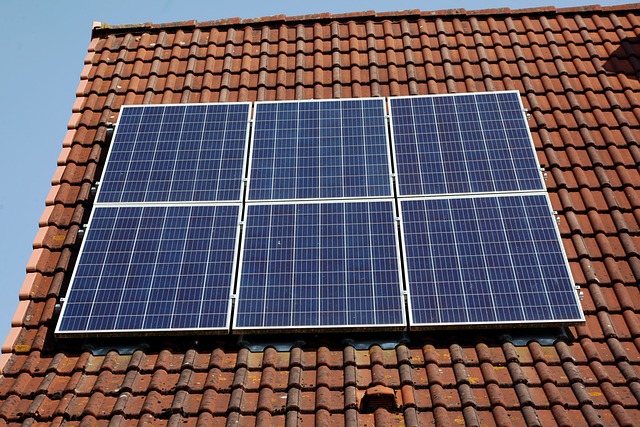
Typical PV installation
Every solar PV system is made up of several components: solar panels (modules), inverter(s), a meter and your existing consumer unit. The process is as follows. The sun produces radiation during daylight hours. The PV cells on the panels turn this radiation into direct current (DC) electricity. The current flows into an inverter, which converts the DC to alternating current (AC) electricity. AC is compatible with the main electricity grid and most electrical appliances; it is ready to use.
The current is fed through a meter and then into your consumer unit. Plug in and switch on! Your system will automatically use the electricity you’ve generated and top-up from the grid as needed. Any electricity you don’t use is exported to the grid for others to use (NI only), stored in a battery provided you installed one with diverter switch and associated equipment, or sent to your hot water cylinder (immersion).
In terms of grid connection, in NI for a typical domestic property with a single phase electrical supply, an array of <3.68kWp1 is deemed as micro-generation and may be fitted without making a grid connection application. The installer arranges connection under a ‘fit & inform’ scheme. Connection is free of charge. For installations >3.68kW single phase or >11kW, three phase, the installation is deemed ‘small scale’ and a grid connection application must be submitted. There is a fee for the application and for connection.
The grid infrastructure in NI is weak and, in many places, is now at capacity for connection of generators. NIE publish a ‘Heat Map’2 that describes the status of the grid across NI.
The system is more complex in ROI. If you want to export the electricity you generate to the grid you must apply to ESB Networks for permission to connect a micro generator (<6kW single phase, <11kW three phase) using Form NC6; they will inform you if they have any objections. You then must accept and pay for the ESB Networks quotation for fitting an import/export meter and submit your ETCI electrical certification after which ESB Networks will fit the meter. However, at present there is little demand, if any, from the electricity companies for purchasing electricity in this way so make sure you have a firm commitment before outlaying the cost of an import/export meter.
The best approach may be to look at alternative uses or storage options for any excess electricity.
PV cost
Off-grid homes have used battery storage for years. These have tended to be large banks of lead acid cells similar to car batteries and can be expensive overall, even if well maintained. However in the case of an off-grid home the cost is offset against that saved from avoiding grid connection or, looking at it another way, you have no choice! For the rest of us, the potential benefits of batteries need to be weighed up against the costs, which currently range from about £3,000 to £8,000 / €6,000, depending on storage capacity and type. Lithium ion is the dominant technology at present.
Retrofitted batteries will generally be AC types, installed between the renewable system and the electricity meter. This requires an inverter to convert the DC output into AC (and back again for storage). DC batteries tend to be fitted when the renewable system is installed and do not require an additional inverter. Issues to be considered with domestic batteries include lifespan (number of charging cycles), capacity/ power output and of course cost (including installation and accounting for the value of the electricity). Some systems can be charged from the grid, allowing variable unit costs at different times of day to be exploited via smart technology.
There is also the possibility of linking electric vehicle batteries with the domestic electricity supply. The EV battery can be charged up overnight on cheap rate electricity and then supply the home with left over energy in the evening when tariffs are higher. However, utilising PVgenerated energy would require domestic batteries as well, as the car is likely to be out during the day (though domestic wind-turbines would not be affected in the same way). An added benefit of domestic battery storage is potential back-up in the event of a power cut though not all systems will do this.
If you have a hot water cylinder another way of storing your electricity is to connect the output to the immersion heater and charge up your hot water. You will need an extra device called
an immersion controller, which costs in the region of €300 / £200 to 400 and is installed after the consumer unit, i.e. using AC current. It will divert supply to the immersion heater any time there is excess. It can also be used in conjunction with an AC battery.
So should owners of PV or domestic wind turbines, or those proposing to install them, rush out and buy batteries? The consensus is not yet – the technology is still developing. Efficiency and reliability will improve as costs fall.
Also, batteries use rare metals that are in finite supply in the earth’s crust. Another emerging technology that can store (and transport) renewables-generated electricity is the hydrogen fuel cell. So watch this space…







